April Showers Bring Flood Tips
April Showers Bring May Flowers. But with April showers can come possible flooding and serious home damage. Here are some tips to safeguard your home and minimize any rainy season-related damage.
Protecting Your Home
Inspect Your Chimney and Roof.
It is better to catch a leak or crack on your roof early to prevent having to make massive repairs in the future. If you have a chimney, it's advisable to hire a professional to check for any cracks that may lead to water infiltration.
Install a Backwater Valve and Sump Pump.
There are a few products that can assist in keeping water out of your home. A sump pump drains water from the inside of a structure to the outside. An additional tip is to try and opt for a battery backup sump pump system to ensure it keeps working even during power outages caused by storms. If you live close to a city, a backwater valve could be very helpful as their purpose is to prevent city sewers from backing up into your basement plumbing fixtures.
Get in contact with your designated plumber for a price estimate and have these products installed. A good plumber will also be able to recommend the best choice of sump pump or backwater valve for your specific needs.
Clean Your Gutters, Windows, Doors, and Other Openings.
A very common issue during the spring rainy season is clogged downspouts and gutters which can lead to damage on your roofline and soffit. If you are cleaning your gutters yourself, start near the downspout and work toward the closed end - clearing most of the debris by hand and flushing out the remaining bits and dirt with a garden hose. If you don't have the ability to do this yourself, it's best to call a professional for a safe removal process.
Make sure to thoroughly clean our windows, doors, and other openings to check for any cracks or damage. If you find any issues, seal them with caulk to prevent water from seeping in and causing more damage. In addition, make sure any wood window and door trim are painted as this can help prevent wood rot and protect your home's structure.
Have the Right Insurance Protection.
A common misconception is that flood insurance is automatically added to your homeowner's insurance policy - this is not true! Flood insurance must be purchased as a separate policy, either privately or through the National Flood Insurance Program. Your agent can explain your options for flood coverage through a federally funded flood carrier. If you are unsure about your coverage, don't hesitate to contact your agent for clarification!
For extra peace of mind, ask your agent about adding sewer or drain backup coverage to your homeowner's insurance policy. This is an endorsement to your existing policy and will provide coverage if water or sewage backs up into your house through sewers/drains, or overflows from a sump pump or other system designed to remove water from your foundation.
Preventing Damage After a Flood
Immediately Clean and Dry the Flooded Areas.
Act quickly to prevent water damage - the longer water remains, the more difficult repairs become. If safe, begin cleaning within 48 hours of flooding. Check all rooms for water, spills, and leaks. If you find areas of flooding, take pictures to provide when submitting a claim. Once you've identified the flooded areas, start cleaning and drying them up promptly. Use a vacuum to dry wet carpets or rugs and run a fan for at least 24 hours to ensure thorough drying.
Check Your Home's Exterior.
After checking your home's interior, it's important to inspect the outside as well. Be on the lookout for any pooling water near the foundation or large water pools on your property. Take note of these areas as they can lead to foundation damage, cracks, and even mold growth.
Dehumidify the House and Watch the Humidity Levels.
Right after a storm or flood, moisture in the air can lead to rapid mold growth. Getting the house as dry as possible is key to keeping mold at bay:
- Open all the windows in your home.
- Turn on all fans.
- Use a dehumidifying machine to keep the air dry, clean, and cool.
- You can also use a humidity monitor to keep an eye on humidity levels. The ideal level is below 60% in the summertime, while 25-40% is normal in the winter.
Sanitize Everything.
Ensure all water-damaged areas, furniture, and items are thoroughly sanitized post-cleaning. Use a steam cleaner or wet and dry vacuum cleaner for sofas, beds, and furniture. If you don't have one, contact the restoration company for assistance. For surfaces like floors and walls, use soap and water to clean and sanitize them using a water-chlorine bleach solution.
Throws Away What Can't Be Cleaned.
Certain items may not be salvageable after water damage, such as electronics. Ensure that these items are included in your insurance claim before discarding them. Providing documentation of all damaged belongings to your claim's professional is necessary for claim approval.
If you have any questions or concerns about Flood coverage, take the time to call your agent and make sure your home is protected from the April showers and floods.





